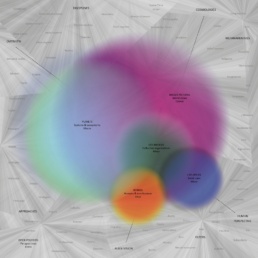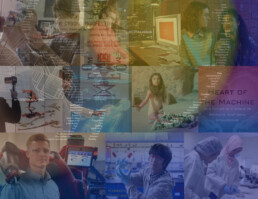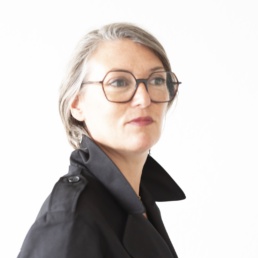About TAC Future Lab
An open laboratory for future exploration
The unprecedented scale of global change and transitions, with their load of fear, anxiety and uncertainty, complexifies the future and calls for innovative foresight approaches – to re-open the future horizon and recreate aspirational visions of the world and of the future.
Our conviction is that behind every future insight or narrative, even when they are down-scaled on a narrower domain or geography, there should be a proper concern for, and investigation of, the bigger picture equations and worldviews.
And rather than celebrating complexity, confusion, or opacity, we consider that, when using the right pluralistic approach, open-mindedness and pedagogy, a certain clarity is possible and contributes to restoring clarity, empowerment, and trust, i.e. the keys to agency.
Created by artist-researcher and futurist Raphaële Bidault-Waddington (RBW), and developed by LIID Future Lab with an ecosystem of occasional partners, TAC Future Lab is an open laboratory to explore the contemporary world’s transformations and the future in all its dimensions and potentialities.
In the spirit of slow research, TAC Future Lab progresses in small steps, following its three main research axes (with many side- and sub-paths), and depending on available means, engagements, and opportunities for collaborative experimentation.
This website documents each of our explorations and experiences resulting in publications, conferences, exhibitions, workshops, and other collaborative experiments, since its creation in 2017 and to be consulted via the Research Journal.
Whether for a 2 hours masterclass, an initial ‘future dive’ workshop, an event or a months-long experiment, please discover our collaborative research modules are to be found here.
An open laboratory for future exploration

The unprecedented scale of global change and transitions, with their load of fear, anxiety and uncertainty, complexifies the future and calls for innovative foresight approaches – to re-open the future horizon and recreate aspirational visions of the world and of the future.
Our conviction is that behind every future insight or narrative, even when they are down-scaled on a narrower domain or geography, there should be a proper concern for, and investigation of, the bigger picture equations and worldviews.
And rather than celebrating complexity, confusion, or opacity, we consider that, when using the right pluralistic approach, open-mindedness and pedagogy, a certain clarity is possible and contributes to restoring clarity, empowerment, and trust, i.e. the keys to agency. Created by artist-researcher and futurist Raphaële Bidault-Waddington (RBW), and developed by LIID Future Lab with an ecosystem of occasional partners, TAC Future Lab is an open laboratory to explore the contemporary world’s transformations and the future in all its dimensions and potentialities.
In the spirit of slow research, TAC Future Lab progresses in small steps, following its three main research axes (with many side- and sub-paths), and depending on available means, engagements, and opportunities for collaborative experimentation.
This website documents each of our explorations and experiences resulting in publications, conferences, exhibitions, workshops, and other collaborative experiments, since its creation in 2017 and to be consulted via the Research Journal.
Whether for a 2 hours masterclass, an initial ‘future dive’ workshop, an event or a months-long experiment, please discover our collaborative research modules are to be found here.
Paradigm Shift & Future Worlds:
Insights on the current paradigm shift and ‘change of world’, the impacts of large-scaled digital, environmental and demographic transitions, the underlying anthropological and epistemological reset, and the diversity of future worlds and futures – of subtopics such as the future of AGI, of Museums, of Oceans, of Knowledge, etc.
Methodological & polygonal innovation:
Design of next generation foresight methodologies and tools, inspired by a diversity of domains (Foresight, Design, Art, World-Building, Anthropology, Post-humanist philosophy, Pedagogy, etc.), and combining a ‘polygonal’ spectrum of perspectives – scales of change, temporal distance, stakeholder view-points, approaches, disciplines, vocabularies, etc.
Art & Foresight:
Transversal reflection on the contribution of Art and artistic research to the future and to the field of Foresight, whether in our critical analysis and future insights (Axe 1), in the design of collaborative research experiments (Axis 2), methods and tools (e.g. art-based research around the TAC Future Canvas), or in a more theoretical perspective.
Designing Future Worlds: Toward Alien Cosmologies
TAC stands for Toward Alien Cosmologies, an expression conceptualized in 2017 as part of a future trend research carried out by LIID Future Lab for Peclers Paris, on the new frontiers of science and technology, with a focus on the exponential rise of Artificial Intelligence.
This study showed the need to zoom out and change of cognitive canvas, to radically open the spectrum of future hypotheses and to explore new visions of the world – what anthropologists call cosmologies –including new ontologies such as AI, and potentially resetting the human condition. This reset toward pluriversal future cosmologies was also evidenced by a trend analysis of cultural diversity and globalization.
A cosmology is a way of ordering (world-building), representing and giving meaning to a/the world – space/time model(s) with material and immaterial ecosystems -, which also means (re)thinking the place of man and life in this uni/pluriverse, and an articulation of past, present and future.
In these future worlds and cosmologies, which the Anthropocene also urges us to imagine, the alien factor stands for the many ‘strange things’ we should live and make a world with: new ontologies such as AI black boxes, extraterrestrial life hypothesis, human and non-human species which still hold so many mysteries, and more generally the ‘irrational’, the uncertain, and the unknown.
This gigantic and truly extraordinary future horizon “towards alien cosmologies”, is an opportunity to explore pluriversal and post-humanist future worlds, a fascinating cognitive challenge, and an open-field for the art of futurescaping.
Designing Future Worlds: Toward Alien Cosmologies

TAC stands for Toward Alien Cosmologies, an expression conceptualized in 2017 as part of a future trend research carried out by LIID Future Lab for Peclers Paris, on the new frontiers of science and technology, with a focus on the exponential rise of Artificial Intelligence.
This study showed the need to zoom out and change of cognitive canvas, to radically open the spectrum of future hypotheses and to explore new visions of the world – what anthropologists call cosmologies –including new ontologies such as AI, and potentially resetting the human condition. This reset toward pluriversal future cosmologies was also evidenced by a trend analysis of cultural diversity and globalization.
A cosmology is a way of ordering (world-building), representing and giving meaning to a/the world – space/time model(s) with material and immaterial ecosystems -, which also means (re)thinking the place of man and life in this uni/pluriverse, and an articulation of past, present and future.
In these future worlds and cosmologies, which the Anthropocene also urges us to imagine, the alien factor stands for the many ‘strange things’ we should live and make a world with: new ontologies such as AI black boxes, extraterrestrial life hypothesis, human and non-human species which still hold so many mysteries, and more generally the ‘irrational’, the uncertain, and the unknown.
This gigantic and truly extraordinary future horizon “towards alien cosmologies”, is an opportunity to explore pluriversal and post-humanist future worlds, a fascinating cognitive challenge, and an open-field for the art of futurescaping.
Development and partner ecosystem
TAC Future Lab continues from past artistic, conceptual and future research conducted by Raphaële Bidault-Waddington in her Art labs and at LIID Future Lab (see liid.fr and below) – for more than twenty years. TAC Future Lab is funded by LIID Future Lab (for which it serves as R&D), with an ecosystem of partnering structures (academia, research center, cultural institution, third space, media, event, international organization, etc.) for specific research episodes (conferences, publications, exhibitions, workshops, experiments).
Some collabs: Duperré Design School, Paris ; Forccast Laboratory, Telecom ParisTech, Paris ; CNRS, Paris ; ISC, Paris ; Anticipated Worlds Festival, Cité des Sciences et de l’Industrie, Paris ; HiFlow, Geneva ; Museum of Art and History, Geneva ; Muzeum Susch, Switzerland ; Louvre Lens Valley, Lens ; Science Fiction Research Association ; World Futures Studies Federation ; Association of Professional Futurists ; etc.
Development and partner ecosystem
TAC Future Lab continues from past artistic, conceptual and future research conducted by Raphaële Bidault-Waddington in her Art labs and at LIID Future Lab (see liid.fr and below) – for more than twenty years. TAC Future Lab is funded by LIID Future Lab (for which it serves as R&D), with an ecosystem of partnering structures (academia, research center, cultural institution, third space, media, event, international organization, etc.) for specific research episodes (conferences, publications, exhibitions, workshops, experiments).
Few collabs: Duperré Design School, Paris ; Forccast Laboratory, Telecom ParisTech, Paris ; CNRS, Paris ; ISC, Paris ; Anticipated Worlds Festival, Cité des Sciences et de l’Industrie, Paris ; HiFlow, Geneva ; Museum of Art and History, Geneva ; Muzeum Susch, Switzerland ; Louvre Lens Valley, Lens ; Science Fiction Research Association ; World Futures Studies Federation ; Association of Professional Futurists ; etc.
LIID Future Lab has conducted very diverse creative and future research projects for and with different structures, some of which are particularly relevant to those of TAC Future Lab.
LIID Future Lab has conducted very diverse creative and future research projects for and with different structures, some of which are particularly relevant to those of TAC Future Lab.
Every year from 2011 to 2023, LIID has produced future trend analyses (international perspective) for Peclers Paris on a wide range of topics such as: identities, diversity and cultural globalization; technologies and the digital era; social, collaborative and urban innovation; ubiquity, mobility and relationship to time and space; relationship to the body, well-being and health; quest for meaning and spirituality.
From 2010 to 2012, LIID worked with Aalto University (Helsinki) on three future-oriented international innovation programs, including one in collaboration with the Institute For The Future in Palo Aalto – as part of the production of its iconic Ten Years Forecast report.
From 2011 to 2017, LIID’s multi-awarded R&D lab Paris Galaxies on the future of Greater Paris metropolis, was an opportunity to design and experiment a series of artistic and (near and far) future research methods, with a pool of academic partners (Paris 1 Pantheon Sorbonne University, Parsons School Paris, Paris College of Art, Paris La Villette National School of Architecture, CNAM, Neoma BS, Campus Fonderie de l’Image).
All these experiences were designed in response to their context but with the support of a core conceptual diagram modeling the metropolitan transformation that served as a very fluid research and pedagogy tool, and allowed to connect and value each experience – as done in TAC Future Lab.
Paris Galaxies Lab terminated in 2017 with the book ‘Paris Ars Universalis, fictional scenario of a Future Greater Paris’, which somehow already prefigured a future world exploration, through the case of the Greater Paris, a Global City and one of the Western universalism’s cradles (to be reinvented).
TAC Future Lab also mobilizes the artistic experience and formats of Raphaële Bidault-Waddington’s other Art labs, such as her practice of conceptual art diagrams and performative installations (Idea Lab), or of photomontages (Image Lab). The Polygon project (Idea Lab) designed for a contemporary art exhibition at Apex Art in NY in 2010, gave birth to the polygonal research principle (multi-faceted / multidisciplinary) and to a first artistic installation serving as a ‘research station’ – experience that fed the design of TAC installation.
Ce principe polygonal d’articulation et de spatialisation physique, mentale ou diagrammatique des points de vue, est poursuivi en 2014-16 dans le projet Sémiospace/Semioscape – diagrammes, expositions à Zurich et Genève, conférences, et livre paru aux éditions Clinamen – en y introduisant cette fois-ci une dimension multi-scalaire (échelle multiple), reprise dans le TAC Future Lab.
This time curating images from the web or generating them with AI, TAC Future Lab also takes up from experiments from RBW’s Image Lab.
The immersive photographic installation Bulle Poetico-Spéculative (2001) was a source of inspiration for the TAC installation.
The practice of photomontage is used to created moodboards associated future insights, or in workshops (image-based research).
The text-image experiments and speculative fictions such as the Republic of Images (Tales Magazine, 2010) or Machination (D-Fiction.fr, 2016-2018) prefigure the design fiction (Duperré, 2018) and future fiction (Forecast Laboratory 2018) experiments in TAC Future Lab.

Bio of Raphaële Bidault-Waddington
An artist-researcher and a futurist, Raphaële Bidault-Waddington has been creating since 2000, artistic and/or future research laboratories forming a live research ecosystem. TAC Future Lab is her latest initiative.
A passionate and 360° researcher with degrees in image theory and immaterial economics, she founded this ecosystem based on the idea that art could be seen as a form of research, both questioning and contributing to the transformations of the world.
A laboratory should here be understood as a conceptual framework to organize and give meaning to research (whether artistic, academic, future-oriented, urban, etc.) around critical topics, and mixing in many ways experimentation and knowledge.
In the last twenty years, her independent laboratories have given her the radical freedom to make experiments (collaborative or not), to innovate and to produce trans-disciplinary knowledge at the crossroads of arts, theory and academia, economics, urban design, politics, digital humanities, philosophy and foresight… This translates into occasional exhibitions and numerous collaborations, publications and conferences in France and abroad.
Bio of Raphaële Bidault-Waddington
An artist-researcher and a futurist, Raphaële Bidault-Waddington has been creating since 2000, artistic and/or future research laboratories forming a live research ecosystem. TAC Future Lab is her latest initiative.
A passionate and 360° researcher with degrees in image theory and immaterial economics, she founded this ecosystem based on the idea that art could be seen as a form of research, both questioning and contributing to the transformations of the world.
A laboratory should here be understood as a conceptual framework to organize and give meaning to research (whether artistic, academic, future-oriented, urban, etc.) around critical topics, and mixing in many ways experimentation and knowledge.
In the last twenty years, her independent laboratories have given her the radical freedom to make experiments (collaborative or not), to innovate and to produce trans-disciplinary knowledge at the crossroads of arts, theory and academia, economics, urban design, politics, digital humanities, philosophy and foresight… This translates into occasional exhibitions and numerous collaborations, publications and conferences in France and abroad.
